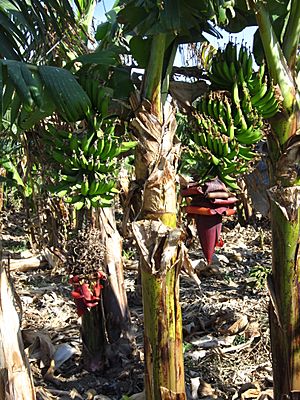Musa × paradisiaca facts for kids
Quick facts for kids Musa × paradisiaca |
|
|---|---|
 |
|
| Scientific classification | |
| Genus: |
Musa
|
| Species: |
× paradisiaca
|
 |
|
| Original native ranges of the ancestors of M. × paradisiaca: M. acuminata is shown in green and M. balbisiana in orange. | |
Musa × paradisiaca is the scientific name for most of the bananas and plantains we eat. It's a hybrid plant, meaning it's a mix of two different wild banana species: Musa acuminata and Musa balbisiana.
Many of the bananas and plantains grown today are special types of this hybrid. They are often "triploid" cultivars. This means they have three sets of chromosomes instead of the usual two. This makes them different from their wild ancestors.
Originally, the scientist Linnaeus used the name M. paradisiaca only for plantains, which are cooking bananas. But today, this name includes all hybrid bananas, whether they are for cooking or for eating fresh as a dessert. Linnaeus's name for dessert bananas, Musa sapientum, is now considered the same as Musa × paradisiaca.
What are Bananas and Plantains?
Almost all cultivated plantains and many cultivated bananas are special types of M. × paradisiaca. These are often "triploid" cultivars. This means they have three sets of genetic information.
Scientists believe that farmers in Southeast Asia first started growing M. acuminata. As these cultivated plants spread to areas where M. balbisiana grew naturally, the two species mixed. This mixing created hybrids, which were then developed into many different types of bananas and plantains.
There are hundreds of different types, or cultivars, of M. × paradisiaca. They have many different features, but they usually look like a mix of their parent plants. These plants typically grow to be about 2 to 9 meters (7 to 30 feet) tall.
The part of the plant that looks like a tree trunk is actually a "false stem" or pseudostem. It's made up of tightly wrapped leaves and their bases. Each pseudostem can produce only one bunch of fruit. After the plant makes fruit, that pseudostem dies. However, new shoots can grow from the base of the plant. Most M. × paradisiaca cultivars don't have seeds or good pollen. This means they can't reproduce easily on their own.
How Bananas Got Their Names
When scientists first started naming plants, Linnaeus gave bananas two different names. He called cooking bananas, or plantains, Musa paradisiaca. He named dessert bananas M. sapientum.
Later, scientists discovered that both of these "species" were actually cultivated types. They were hybrids of two wild species: Musa acuminata and Musa balbisiana. So, the name M. × paradisiaca L. was created for this hybrid.
Today, the scientific name M. × paradisiaca includes both the original M. paradisiaca and M. sapientum. This means M. sapientum is now considered a synonym of M. × paradisiaca.
To help organize the many types of cultivated bananas and plantains, botanists now use "cultivar names." These names help us tell the different types apart. Cultivars are also put into groups and subgroups. For example, M. × paradisiaca 'Horn' is a specific type of plantain. It belongs to a group called the AAB genome group, in the Plantain subgroup. You can find more details about how bananas are named and classified in the List of banana cultivars.
See also
 In Spanish: Banano para niños
In Spanish: Banano para niños

